The Climate, Land, Energy, Water and Food Nexus Challenge in a Land Scarce Country: Innovations in the Netherlands
Abstract
:1. Introduction
2. Literature Review: Definitions, Categorisations and Relevance for Sustainability
2.1. The Use of the Innovation Concept
2.2. Types of Innovation
2.3. The Relation between Innovation and the Energy Transition
3. Materials and Methods
3.1. Methodology
3.2. Application of the DPSIR to the CLEWF Nexus
- Renewable energy deployment (e.g., renewable energy sources have larger spatial requirements than non-renewables);
- Energy intensity of the economy/energy efficiency (e.g., demand for energy drives and demand for land to generate this energy on);
- Resource use and disposal (e.g., waste recycling and circularity could not only reduce spatial requirements for landfills but, perhaps more importantly, reduce the demand for virgin resources and therefore mining);
- Mobility (e.g., population density could form an opportunity for sustainable modes of transport rather than a challenge, yet the Netherlands is not necessarily a frontrunner on green mobility in Europe);
- Agricultural emissions (e.g., food choices greatly affect land requirements for agriculture).
3.3. Benchmarking
3.4. An Inventory of Innovations for the Dutch Nexus
3.5. Impact/Effort Analysis
3.6. Energy transition Path Analysis
4. Results
4.1. Contents of the Innovation Inventory
4.2. Energy Transition Paths of Belgium, Denmark, Germany, Latvia and Sweden
5. Discussion and Recommendations
5.1. Innovations to Address the Land Scarcity Constraint
5.1.1. District Heating: Relation with Land Scarcity and Recommendations for Implementation
5.1.2. ESCOs: Relation with Land Scarcity and Recommendations for Implementation
5.1.3. Using Water Pumping for Peak Shaving: Relation with Land Scarcity and Recommendations for Implementation
5.2. Energy Transition Paths
5.3. Limitations and Suggestions for Future Work
6. Conclusions
Author Contributions
Funding
Conflicts of Interest
References
- UNFCCC. Paris Agreement. 2015. Available online: https://unfccc.int/files/meetings/paris_nov_2015/application/pdf/paris_agreement_english_.pdf (accessed on 8 April 2019).
- UNFCCC. What Is the Paris Agreement?|UNFCCC. United Nations Climate Change. 2015. Available online: https://unfccc.int/files/essential_background/convention/application/pdf/english_paris_agreement.pdf (accessed on 23 January 2019).
- European Commission. 2020 Climate & Energy Package. 2009. Available online: https://ec.europa.eu/clima/policies/strategies/2020_en (accessed on 23 January 2019).
- De Rijksoverheid. Klimaatakkoord. 2019. Available online: https://www.klimaatakkoord.nl/documenten/publicaties/2019/06/28/klimaatakkoord (accessed on 23 January 2019).
- Selnes, T.; Linderhof, V.; Marinissen, R. The Netherlands Case Study: Policy analysis. In SIM4NEXUS D2.2 Nexus-Relevant Policies in the Transboundary, National and Regional Case Studies Background Report; Munaretto, S., Ed.; Wageningen Economic Research, 2018; Available online: https://www.sim4nexus.eu/userfiles/Deliverables/Deliverable%202.2_Policy%20analysis%20case%20studies_background-report_2019.02.21.pdf (accessed on 5 November 2020).
- Remkes, J.W.; van Dijk, J.J.; Dijkgraaf, E.; Freriks, A.; Gerbrandy, G.J.; Maij, W.H.; Nijhof, A.G.; Post, E.; Rabbinge, R.; Scholten, M.T.; et al. Niet Alles Kan Overal: Eindadvies over Structurele Aanpak op Lange Termijn. No. Adviescollege Stikstofproblematiek, Amersfoort. 2020. Available online: https://www.rijksoverheid.nl/documenten/rapporten/2020/06/08/niet-alles-kan-overal (accessed on 5 November 2020).
- European Commission. Clean Energy for All Europeans COM/2016/0860. 2016. Available online: http://eur-lex.europa.eu/legal-content/EN/TXT/?qid=1512481277484&uri=CELEX:52016DC0860 (accessed on 24 January 2019).
- European Commission. 2030 Climate & Energy Framework. 2019. Available online: https://ec.europa.eu/clima/policies/strategies/2030_en (accessed on 23 January 2019).
- European Commission. Renewable Energy Directive. 2019. Available online: https://ec.europa.eu/energy/en/topics/renewable-energy/renewable-energy-directive (accessed on 11 April 2019).
- Schoots, K.; Hekkenberg, M.; Hammingh, P. Nationale Energieverkenning 2017; ECN-O--17-018; Petten Energieonderzoek Cent. Ned.: Amsterdam/Petten, The Netherlands, 2017; pp. 1–276. [Google Scholar]
- Eurostat. Share of Energy from Renewable Sources. 2020. Available online: https://ec.europa.eu/eurostat/databrowser/view/NRG_IND_REN/default/table?lang=en (accessed on 5 November 2020).
- CBS. Nederland Telt 17 Miljoen Inwoners. 2016. Available online: https://www.cbs.nl/nl-nl/nieuws/2016/12/nederland-telt-17-miljoen-inwoners (accessed on 18 April 2019).
- Bos, J.F.F.P.; Smit, A.L.; Schröder, J.J. Is agricultural intensification in the Netherlands running up to its limits? NJAS Wagening J. Life Sci. 2013, 66, 65–73. [Google Scholar] [CrossRef] [Green Version]
- Van Zalk, J.; Behrens, P. The spatial extent of renewable and non-renewable power generation: A review and meta-analysis of power densities and their application in the U.S. Energy Policy 2018, 123, 83–91. [Google Scholar] [CrossRef]
- Horlings, E.; Hoeksma, L.; van der Ven, K.; Pieters, A. CBS, SDGs in the Netherlands—Status Report 2020. 2020. Available online: https://www.cbs.nl/nl-nl/publicatie/2020/27/sdg-s-in-nederland-statusrapport-2020 (accessed on 18 April 2019).
- OECD and Eurostat. Oslo Manual 2018: Guidelines for Collecting, Reporting and Using Data on Innovation, 4th Edition; The Measurement of Scientific, Technological and Innovation Activities; OECD Publishing: Luxembourg, 2018. [Google Scholar] [CrossRef]
- Fosaas, M.; Sapprasert, K. Innovation: Exploring the knowledge base. Res. Policy 2012, 41, 1132–1153. [Google Scholar] [CrossRef]
- Schumpeter, J. Capitalism, Socialism and Democracy; Harper Brother: New York, NY, USA, 1942. [Google Scholar]
- Gault, F. Defining and measuring innovation in all sectors of the economy. Res. Policy 2018, 47, 617–622. [Google Scholar] [CrossRef]
- OECD and Eurostat. Oslo Manual: Guidelines for Collecting and Interpreting Innovation Data, 3rd ed.; The Measurement of Scientific and Technological Activities; OECD Publishing: Paris, France, 2005. [Google Scholar] [CrossRef]
- Fleurbaey, M. Beyond GDP: The Quest for a Measure of Social Welfare. J. Econ. Lit. 2009, 47, 1029–1075. [Google Scholar] [CrossRef]
- Joint UNECE/Eurostat/OECD Task Force on Measuring Sustainable Development. Framework and Suggested Indicators to Measure Sustainable Development; OECD Publishing: Paris, France, 2013; pp. 41–44. [Google Scholar]
- Raworth, K. Doughnut Economics; Random House: London, UK, 2019. [Google Scholar]
- Ward, J.D.; Sutton, P.C.; Werner, A.D.; Costanza, R.; Mohr, S.H.; Simmons, C.T. Is decoupling GDP growth from environmental impact possible? PLoS ONE 2016, 11, e164733. [Google Scholar] [CrossRef] [PubMed] [Green Version]
- Baker, S. Sustainable Development; Routledge: Oxon, UK, 2006. [Google Scholar]
- Polman, N.B.P.; Slee, B.; Kluvánková, T.; Dijkshoorn-Dekker, M.W.C.; Nijnik, M.; Gežik, V.; Soma, K. Classification of Social Innovations for Marginalized Rural Areas. 2017. Available online: http://www.simra-h2020.eu/wp-content/uploads/2017/09/D2.1-Classification-of-SI-for-MRAs-in-the-target-region.pdf (accessed on 13 May 2019).
- Irandoust, M. Innovations and renewables in the Nordic countries: A panel causality approach. Technol. Soc. 2018, 54, 87–92. [Google Scholar] [CrossRef]
- Lin, B.; Zhu, J. The role of renewable energy technological innovation on climate change: Empirical evidence from China. Sci. Total Environ. 2019, 659, 1505–1512. [Google Scholar] [CrossRef] [PubMed]
- Hoppe, T.; de Vries, G. Social innovation and the energy transition. Sustainability 2018, 11, 141. [Google Scholar] [CrossRef] [Green Version]
- Aldieri, L.; Bruno, B.; Vinci, C.P. Does environmental innovation make us happy? An empirical investigation. Socioecon. Plann. Sci. 2018. [Google Scholar] [CrossRef]
- Kristensen, P. The DPSIR Framework Background 1. 2004. Available online: https://wwz.ifremer.fr/dce/content/download/69291/913220/.../DPSIR.pdf (accessed on 24 April 2019).
- Kuzemko, C.; Mitchell, C.; Lockwood, M.; Hoggett, R. Policies, politics and demand side innovations: The untold story of Germany’s energy transition. Energy Res. Soc. Sci. 2017, 28, 58–67. [Google Scholar] [CrossRef]
- Federal Ministry for Economic Affairs (BMWi). Energy Efficiency—Made in Germany. Energy Efficiency in Industry, Building Service Technology and Transport. 2010. Available online: www.bmwi.de (accessed on 24 May 2019).
- Rutten, D. The Energiewende and Germany’s Industrial Policy. Clingendael International Energy Programme (CIEP). 2014. Available online: www.clingendaelenergy.com (accessed on 24 May 2019).
- Rosenow, J. Politics of Change: Energy Efficiency Policy in Britain and Germany. Ph.D. Thesis, Oxford University, Oxford, UK, 2013. [Google Scholar]
- Kuittinen, H.; Velte, D. Case Study Report Energiewende. Energeia 2018. [Google Scholar] [CrossRef]
- Clean Energy Wire. Germany’s Energiewende—The Easy Guide. 2018. Available online: https://www.cleanenergywire.org/easyguide (accessed on 24 May 2019).
- Agora Energiewende. Understanding the Energiewende. 2015. Available online: www.agora-energiewende.de (accessed on 24 May 2019).
- Sturm, C. Inside the Energiewende: Policy and Complexity in the German Utility Industry. Issues Sci. Technol. 2017. Available online: https://issues.org/inside-the-energiewende-policy-and-complexity-in-the-german-utility-industry/ (accessed on 24 May 2019).
- Millsap, R.E. The German Gamble: An Analysis of the Energiewende Policy and Its Implications for Energy Security in Europe. 2018. Available online: https://bearworks.missouristate.edu/theses (accessed on 24 May 2019).
- Borup, M.; Andersen, P.D.; Jacobsson, S.; Midttun, A. Nordic Energy Innovation Systems-Patterns of Need Integration and Cooperation. 2008. Available online: www.bi.no (accessed on 27 May 2019).
- Jørgensen, M.S.; Jørgensen, U.; Jensen, J.S. Navigations and governance in the Danish energy transition reflecting changing Arenas of Development, controversies and policy mixes. Energy Res. Soc. Sci. 2017, 33, 173–185. [Google Scholar] [CrossRef]
- Danish Energy Agency. The Danish Energy Model Innovative, Efficient and Sustainable. 2016. Available online: www.ens.dk/en (accessed on 27 May 2019).
- IEA. Energy Policies of IEA Countries 2016 Review Belgium. 2016. Available online: www.iea.org/t&c/ (accessed on 28 May 2019).
- Edquist, C. Towards a holistic innovation policy: Can the Swedish National Innovation Council (NIC) be a role model? Res. Policy 2019. [Google Scholar] [CrossRef]
- Uba, K. Who formulates renewable-energy policy? A Swedish example. Energy Policy 2010, 38, 6674–6683. [Google Scholar] [CrossRef]
- Wang, Y. Renewable electricity in Sweden: An analysis of policy and regulations. Energy Policy 2006, 34, 1209–1220. [Google Scholar] [CrossRef]
- Sarasini, S. Constituting leadership via policy: Sweden as a pioneer of climate change mitigation. Mitig. Adapt. Strateg. Glob. Chang. 2009, 14, 635–653. [Google Scholar] [CrossRef]
- Nilsson, L.J.; Johansson, B.; Åstrand, K.; Ericsson, K.; Svenningsson, P.; Börjesson, P.; Neij, L. Seeing the wood for the trees: 25 years of renewable energy policy in Sweden. Energy Sustain. Dev. 2004, 8, 67–81. [Google Scholar] [CrossRef]
- Swedish Energy Authority. Energie Läget 2008 (The Energy Situation 2008); Modintryckoffset: Stockholm, Sweden, 2008; ISSN 1403-1892. [Google Scholar]
- Locmelis, K.; Bariss, U.; Blumberga, D. Latvian Energy Policy on Energy Intensive Industries. Energy Procedia 2017, 113, 362–368. [Google Scholar] [CrossRef]
- Timma, L.; Zoss, T.; Blumberga, D. Life after the financial crisis. Energy intensity and energy use decomposition on sectorial level in Latvia. Appl. Energy 2016, 162, 1586–1592. [Google Scholar] [CrossRef]
- Shipkovs, P.; Kashkarova, G.; Shipkovs, M. Renewable energy utilization in Latvia. Renew. Energy 1999, 16, 1241–1244. [Google Scholar] [CrossRef]
- Prodanuks, T.; Cimdina, G.; Veidenbergs, I.; Blumberga, D. Sustainable Development of Biomass CHP in Latvia. Energy Procedia 2016, 95, 372–376. [Google Scholar] [CrossRef] [Green Version]
- Nuclear Energy Agency [NEA] and OECD. Denmark: Nuclear Legislation in OECD and NEA Countries. 2015. Available online: https://www.oecd-nea.org/law/legislation/denmark.pdf (accessed on 31 May 2019).
- IRENA. 30 Years of Policies for Wind Energy; 2012; pp. 54–64. Available online: https://www.irena.org/-/media/Files/IRENA/Agency/Publication/2013/GWEC_WindReport_All_web-display.pdf (accessed on 31 May 2019).
- Technopolis. Country Study-Belgium. 2016. Available online: https://www.topsectorenergie.nl/sites/default/files/uploads/Systeemintegratie/ICET%20Country%20Study%20Belgium.pdf (accessed on 1 June 2019).
- IEA. Climate Change Policies and Measures Databases. 2019. Available online: https://www.iea.org/policiesandmeasures/climatechange/ (accessed on 24 June 2019).
- IEA and IRENA. Renewable Energy IEA/IRENA Joint Policies and Measures Database. 2019. Available online: https://www.iea.org/policiesandmeasures/renewableenergy/ (accessed on 24 June 2019).
- IEA. Energy Efficiency Policies and Measures Databases. 2019. Available online: https://www.iea.org/policiesandmeasures/energyefficiency/ (accessed on 24 June 2019).
- Perruchas, F.; Consoli, D.; Barbieri, N. Green Innovation: An Empirical Analysis of Technology, Skills and Policy. LIBRARY (LOND). 2019. Available online: https://riunet.upv.es/bitstream/handle/10251/119965/Perruchas%E2%80%94Green%20Innovation%3A%20an%20empirical%20analysis%20of%20technology%2C%20skills%20and%20policy.pdf?sequence=4&isAllowed=y (accessed on 15 July 2019).
- Stanners, D.; Bosch, P.; Dom, A.; Gabrielsen, P.; Gee, D.; Martin, J.; Rickard, L.; Weber, J.L. Frameworks for Environmental Assessment and Indicators at the EEA. 2007. Available online: http://wedocs.unep.org/bitstream/handle/20.500.11822/18902/Frameworks_for_environmental_assessment_and_in.pdf?sequence=1&isAllowed=y (accessed on 24 April 2019).
- Centraal Bureau voor de Statistiek. Monitor Brede Welvaart; Centraal Bureau voor de Statistiek: The Hague, The Netherlands, 2018. [Google Scholar]
- Cambridge English Dictionary. Benckmark—Meaning. 2019. Available online: https://dictionary.cambridge.org/dictionary/english/benchmark (accessed on 15 July 2019).
- Merriam-Webster Dictionary. Definition of Benchmark. 1952. Available online: https://www.merriam-webster.com/dictionary/benchmark (accessed on 15 July 2019).
- Collins English Dictionary. Benchmarking Definition and Meaning. 2019. Available online: https://www.collinsdictionary.com/dictionary/english/benchmarking (accessed on 15 July 2019).
- Business Dictionary, What Is Benchmarking? Definition and Meaning. 2019. Available online: http://www.businessdictionary.com/definition/benchmarking.html (accessed on 15 July 2019).
- Eurostat. Greenhouse Gas Emissions in ESD Sectors. 2019. Available online: https://ec.europa.eu/eurostat/tgm/graph.do?tab=graph&plugin=1&pcode=t2020_35&language=en&toolbox=data (accessed on 11 April 2019).
- European Parliament and Council of the European Union. Regulation (EU) 2018/842 of the European Parliament and of the Council o. 2018. Available online: https://eur-lex.europa.eu/legal-content/EN/TXT/PDF/?uri=CELEX:32018R0842&from=EN (accessed on 21 April 2019).
- EEA. Per Capita Greenhouse Gas Emissions. 2018. Available online: https://ec.europa.eu/eurostat/tgm/table.do?tab=table&init=1&plugin=1&language=en&pcode=t2020_rd300 (accessed on 8 April 2019).
- Eurostat. Renewable Energy Statistics—Statistics Explained. 2017. Available online: https://ec.europa.eu/eurostat/statistics-explained/index.php?title=Renewable_energy_statistics (accessed on 8 April 2019).
- Eurostat. Energy Intensity of the Economy. 2017. Available online: https://ec.europa.eu/eurostat/statistics-explained/index.php?title=File:Energy_intensity_of_the_economy,_2005_and_2015_(kg_of_oil_equivalent_per_1_000_EUR_of_GDP)_YB17.png (accessed on 8 April 2019).
- European Patent Office, PATSTAT. Worldwide Patent Statistical Database. Available online: https://www.epo.org/searching-for-patents/business/patstat.html#tab-1 (accessed on 15 July 2019).
- Dziallas, M.; Blind, K. Innovation indicators throughout the innovation process: An extensive literature analysis. Technovation 2019, 80–81, 3–29. [Google Scholar] [CrossRef]
- Geels, F.W. Disruption and low-carbon system transformation: Progress and new challenges in socio-technical transitions research and the Multi-Level Perspective. Energy Res. Soc. Sci. 2018, 37, 224–231. [Google Scholar] [CrossRef]
- Dodgson, J.S.; Spackman, M.; Pearman, A.; Phillips, L.D. Multi-Criteria Analysis: A Manual; Department for Communities and Local Government: London, UK, 2009; Volume 11. [Google Scholar]
- Woods, P.; Overgaard, J. Historical development of district heating and characteristics of a modern district heating system. Adv. Dist. Heat. Cool. Syst. 2016, 3–15. [Google Scholar] [CrossRef]
- Planbureau Voor de Leefomgeving. Balans van de Leefomgeving 2018—Nederland Duurzaam Vernieuwen. 2018. Available online: https://themasites.pbl.nl/balansvandeleefomgeving/wp-content/uploads/pbl-2018-balans-van-de-leefomgeving-2018-3160.pdf (accessed on 3 May 2019).
- Rasmussen, L.H. A sustainable energy-system in Latvia. Appl. Energy 2003, 76, 1–8. [Google Scholar] [CrossRef] [Green Version]
- Boza-Kiss, B.; Bertoldi, P.; Economidou, M. Energy Service Companies in the EU—Status review and recommendations for further market development with a focus on Energy Performance Contracting. ISPRA Jt. Res. Cent. 2017. [Google Scholar] [CrossRef]
- United States Department of Energy. Energy Service Companies. 2019. Available online: https://www.energy.gov/eere/femp/energy-service-companies-0 (accessed on 3 July 2019).
- Pothof, I. Energiebesparing Malen. 2019. Available online: https://publicwiki.deltares.nl/display/DEL029 (accessed on 3 July 2019).
- Chang, M.; Verbree, J.-M.; van den Berg, H.; Reitsma, B. De (on)Mogelijkheden van Flexibel Energiemanagement op Rioolwaterzuiverings-Inrichtingen; Stichting Toegepast Onderzoek Waterbeheer: Amersfoort, The Netherlands, 2018. [Google Scholar]
- Kuipers, H.; van Esch, B.; Meijnburg, M.; Grispen, J.; Pothof, I. Energie- en Kostenreductie in Boezem- en Polderbemaling. 2016. Available online: https://publicwiki.deltares.nl/download/attachments/123538847/Projectvoorstel%20JIP_Gemalen_final.pdf?version=1&modificationDate=1557905418588&api=v2 (accessed on 3 July 2019).
- Kutkut, N. Energy Management through Peak Shaving and Demand Response: New Opportunities for Energy Savings at Manufacturing and Distribution Facilities. 2006. Available online: https://act-chargers.com/wp-content/uploads/2017/03/ACT-White-Paper-Energy-Management-through-Peak-Shaving-and-Demand-Response.pdf (accessed on 6 July 2019).
- Eurostat. Share of Energy from Renewable Sources. 2019. Available online: http://appsso.eurostat.ec.europa.eu/nui/show.do?dataset=nrg_ind_ren&lang=en (accessed on 8 April 2019).
- Euroheat & Power. District Energy Explained. 2019. Available online: https://www.euroheat.org/knowledge-hub/district-energy-explained/ (accessed on 1 July 2019).
- Lund, H.; Möller, B.; Mathiesen, B.V.; Dyrelund, A. The role of district heating in future renewable energy systems. Energy 2010, 35, 1381–1390. [Google Scholar] [CrossRef]
- Rezaie, B.; Rosen, M.A. District heating and cooling: Review of technology and potential enhancements. Appl. Energy 2012, 93, 2–10. [Google Scholar] [CrossRef]
- Werner, S. International review of district heating and cooling. Energy 2017, 137, 617–631. [Google Scholar] [CrossRef]
- Fernández, M.G.; Roger-Lacan, C.; Gährs, U.; Aumaitre, V. Efficient District Heating and Cooling Systems in the EU—Case Studies Analysis Replicable Key Success Factors and Potential Policy Implications; Publications Office of the European Union: Luxembourg, 2016. [Google Scholar] [CrossRef]
- Paardekooper, S.; Lund, R.S.; Mathiesen, B.V.; Chang, M.; Petersen, U.R.; Grundahl, L.; David, A.; Dahlbæk, J.; Kapetanakis, I.A.; Lund, H.; et al. Aalborg Universitet Heat Roadmap Netherlands Quantifying the Impact of Low-Carbon Heating and Cooling Roadmaps. 2018. Available online: www.heatroadmap.eu (accessed on 12 July 2019).
- Bertoldi, B.; Boza-Kiss, B.; Rezessy, S. Latest Development of Energy Service Companies across Europe; Publications Office of the European Union: Luxembourg, 2007. [Google Scholar] [CrossRef]
- Boza-Kiss, B.; Panev, S.; Bertoldi, P. The European ESCO market: Recent trends, market sizes, barriers and drivers and the remaining market potential. Eceee 2015, 2015, 445–454. [Google Scholar]
- IEA. The Netherlands. 2019. Available online: https://www.iea.org/topics/energyefficiency/escos/TheNetherlands/ (accessed on 14 July 2019).
- IEA. Germany. 2019. Available online: https://www.iea.org/topics/energyefficiency/escos/Germany/ (accessed on 14 July 2019).
- Vreeken, R. The Developed Energy Service Company Markets in the European Union—What Lessons Can Be Drawn for the Development of the Dutch ESCO Market? 2012. Available online: https://dspace.library.uu.nl/bitstream/handle/1874/266887/Afstudeerscriptie%20definitieve%20versie%20%28PUBLIEK%29%20-%20Roel%20Vreeken.pdf?sequence=1 (accessed on 14 July 2019).
- Roskam, S.; Piessens, T.; Thijssen, I. Market Report on the Dutch EPC Market. 2016. Available online: https://guarantee-project.eu/nl/wp-content/uploads/sites/15/2017/01/Market-Report-NL.pdf (accessed on 14 July 2019).
- Energiefonds Overijssel. 2019. Available online: https://www.energiefondsoverijssel.nl/ (accessed on 14 July 2019).
- STOWA. Persbericht Waterschappen Gaan Enerrgie Besparen met ‘Slim Malen’. 2018. Available online: https://www.google.com/url?sa=t&rct=j&q=&esrc=s&source=web&cd=&ved=2ahUKEwim95aOrMvtAhWmsKQKHYXOC_sQFjABegQIAhAC&url=https%3A%2F%2Fpublicwiki.deltares.nl%2Fdownload%2Fattachments%2F123539756%2F2016%2520mrt%2520Persbericht%2520%2527Slim%2520Malen%2527.pdf%3Fversion%3D1%26modificationDate%3D1476098523127%26api%3Dv2&usg=AOvVaw1iuotPSNTz82IjBWTcMXvl (accessed on 3 July 2019).
- Slingerland, S.; Rothengatter, N.; van der Veen, R.; Bolscher, H.; Rademaekers, K. The Balance of Power-Flexibility Options for the Dutch Electricity Market. 2015. Available online: http://trinomics.eu/wp-content/uploads/2015/06/The-Balance-of-Power-–-Flexibility-Options-for-the-Dutch-Electricity-Market-final-report.pdf (accessed on 6 July 2019).
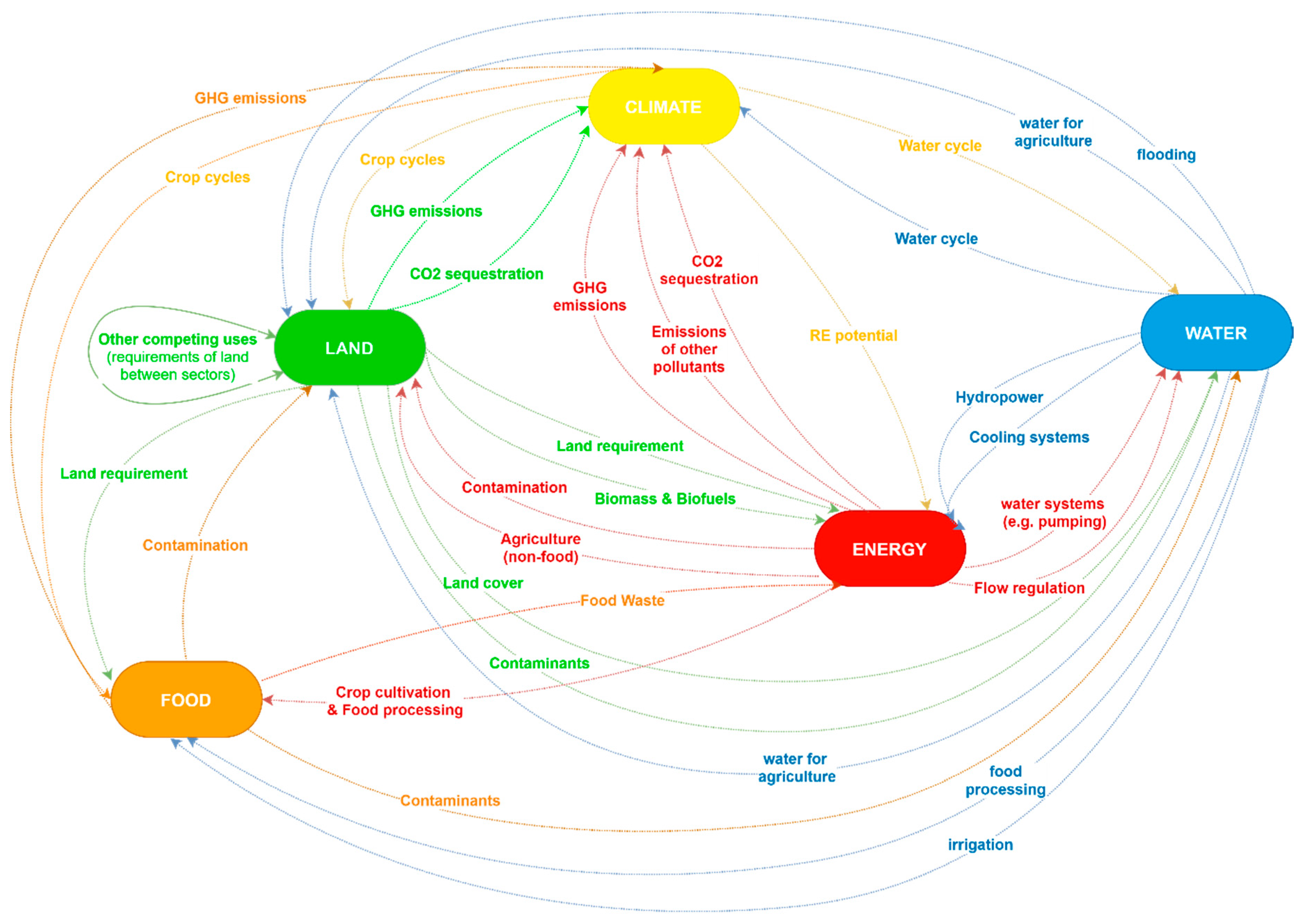
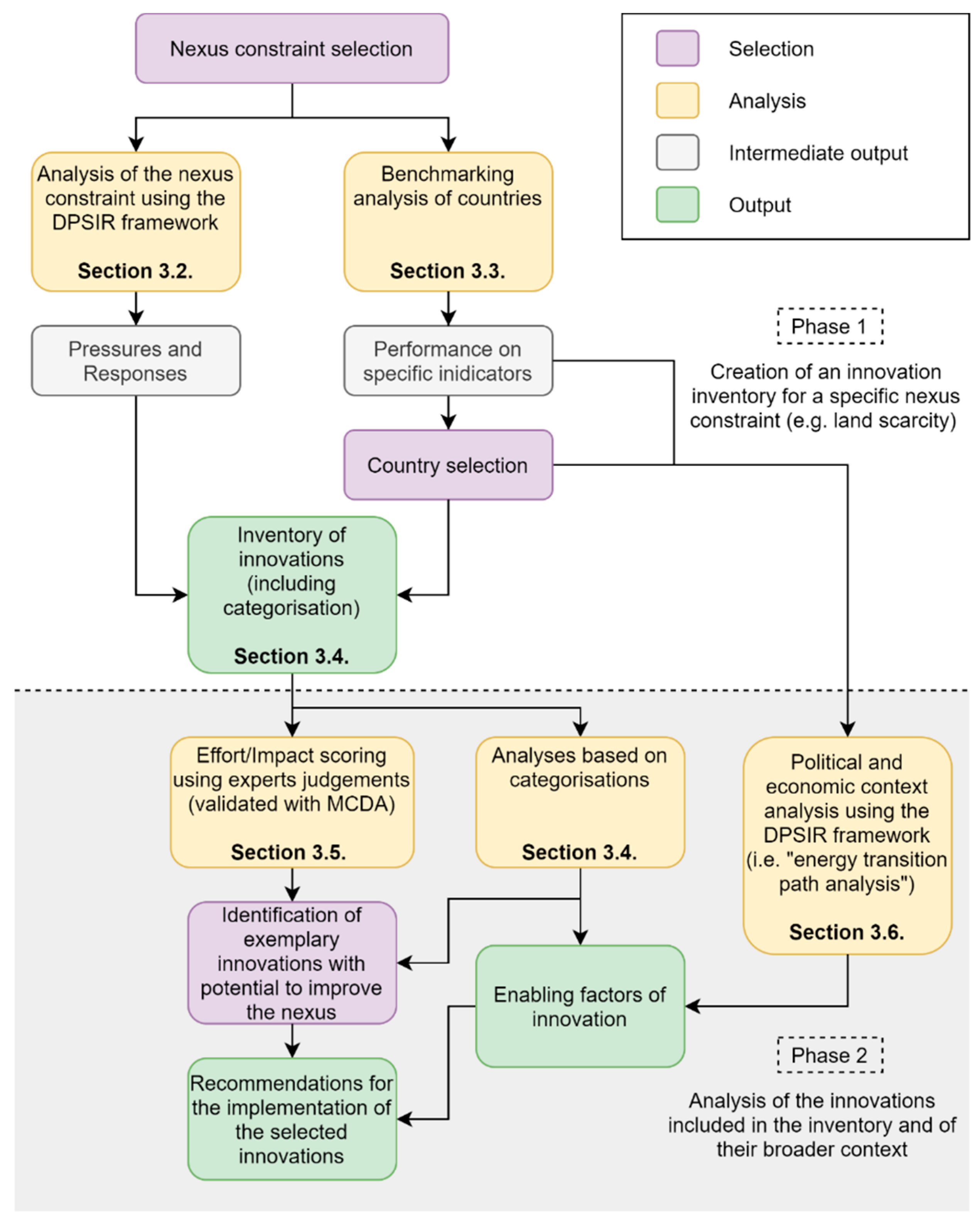
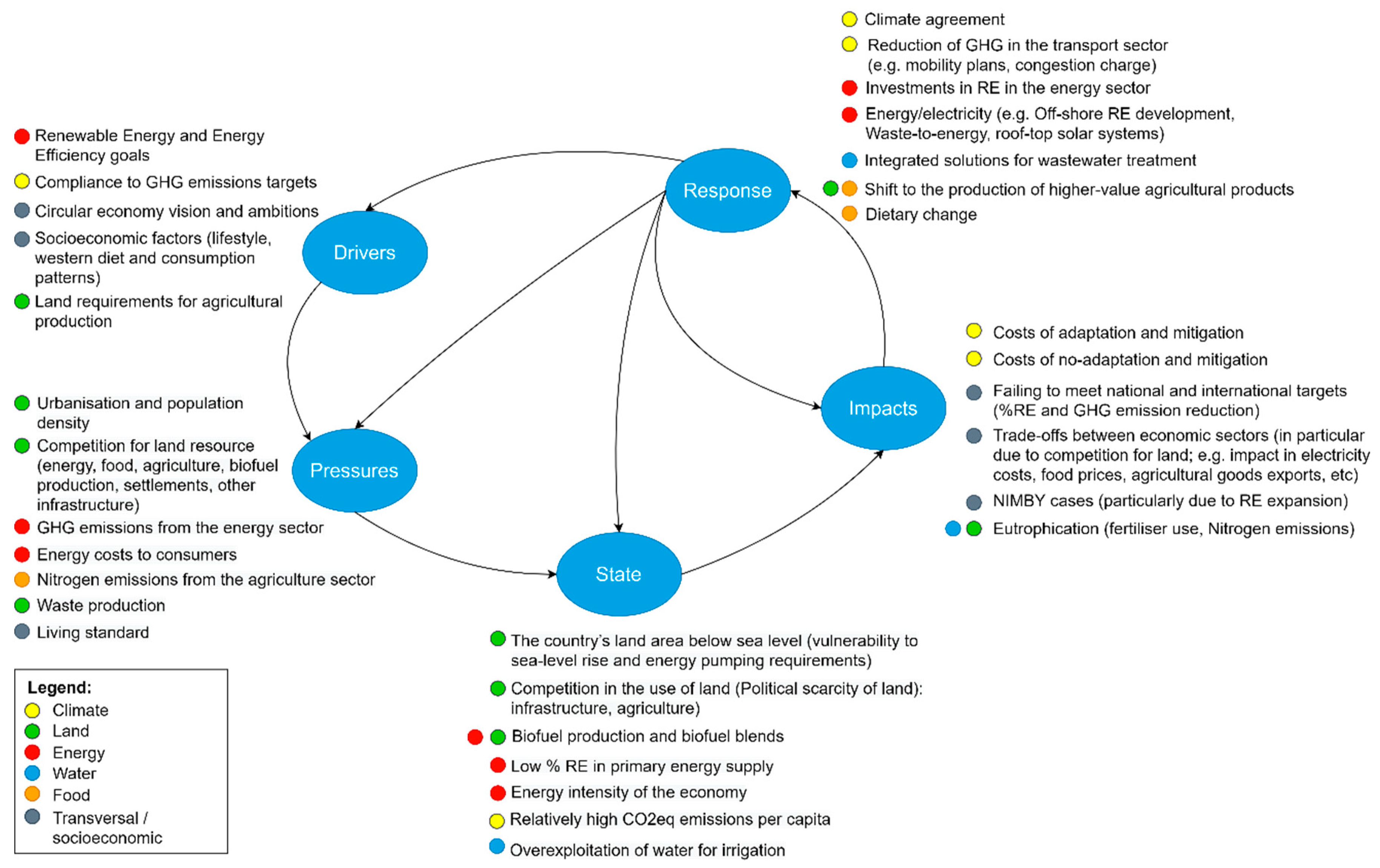
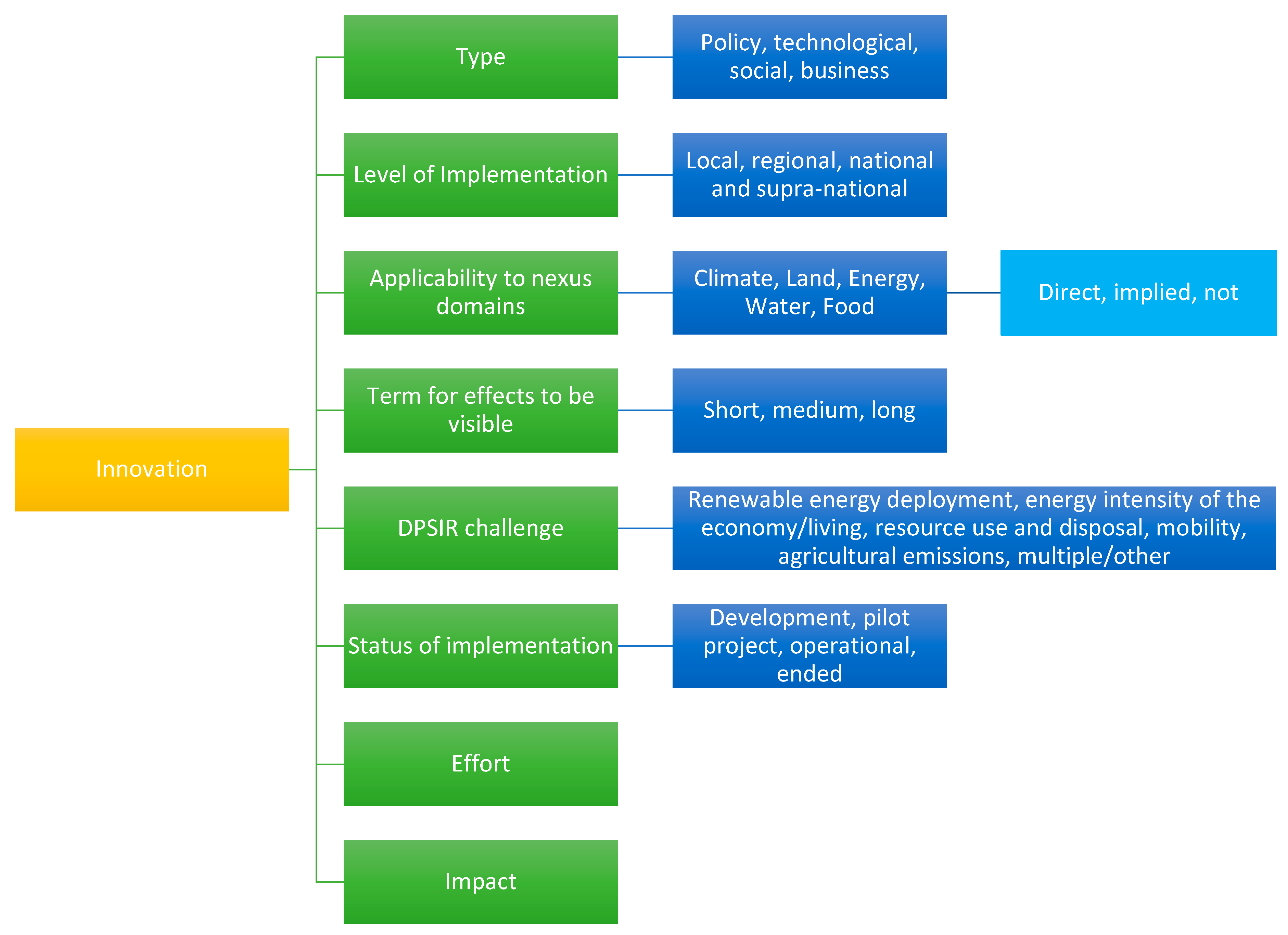


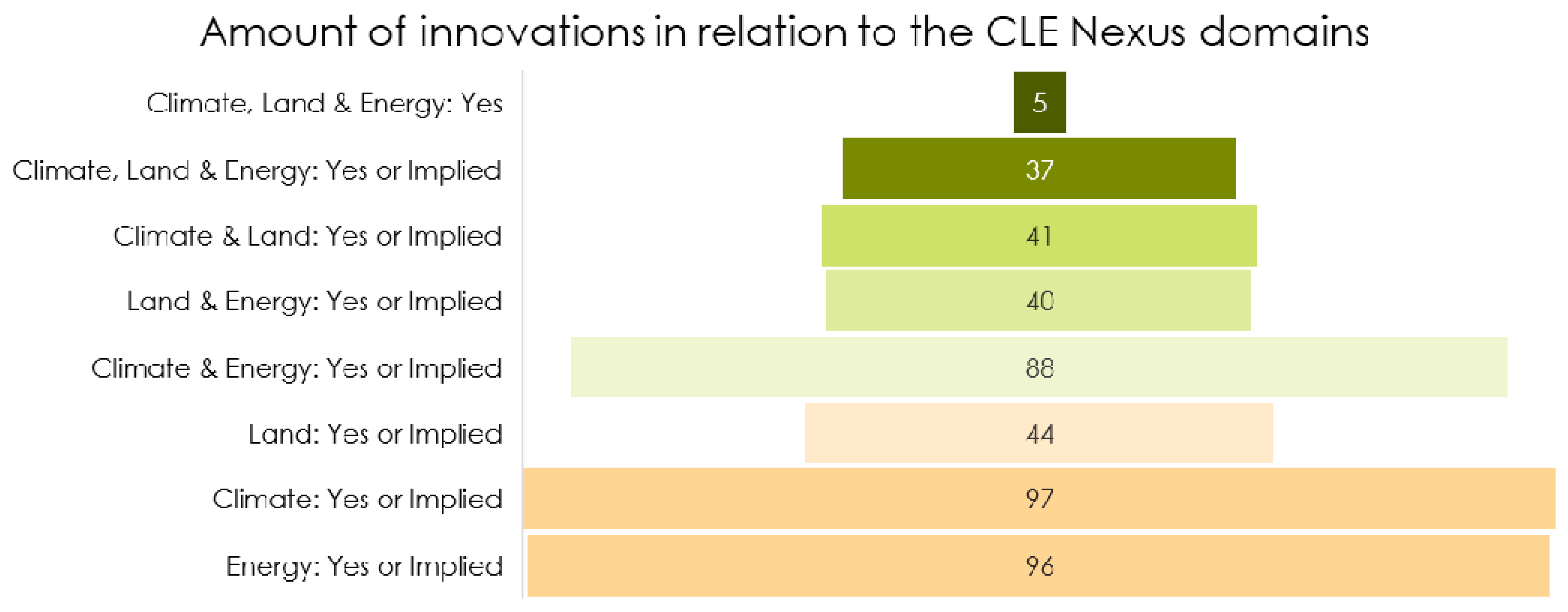

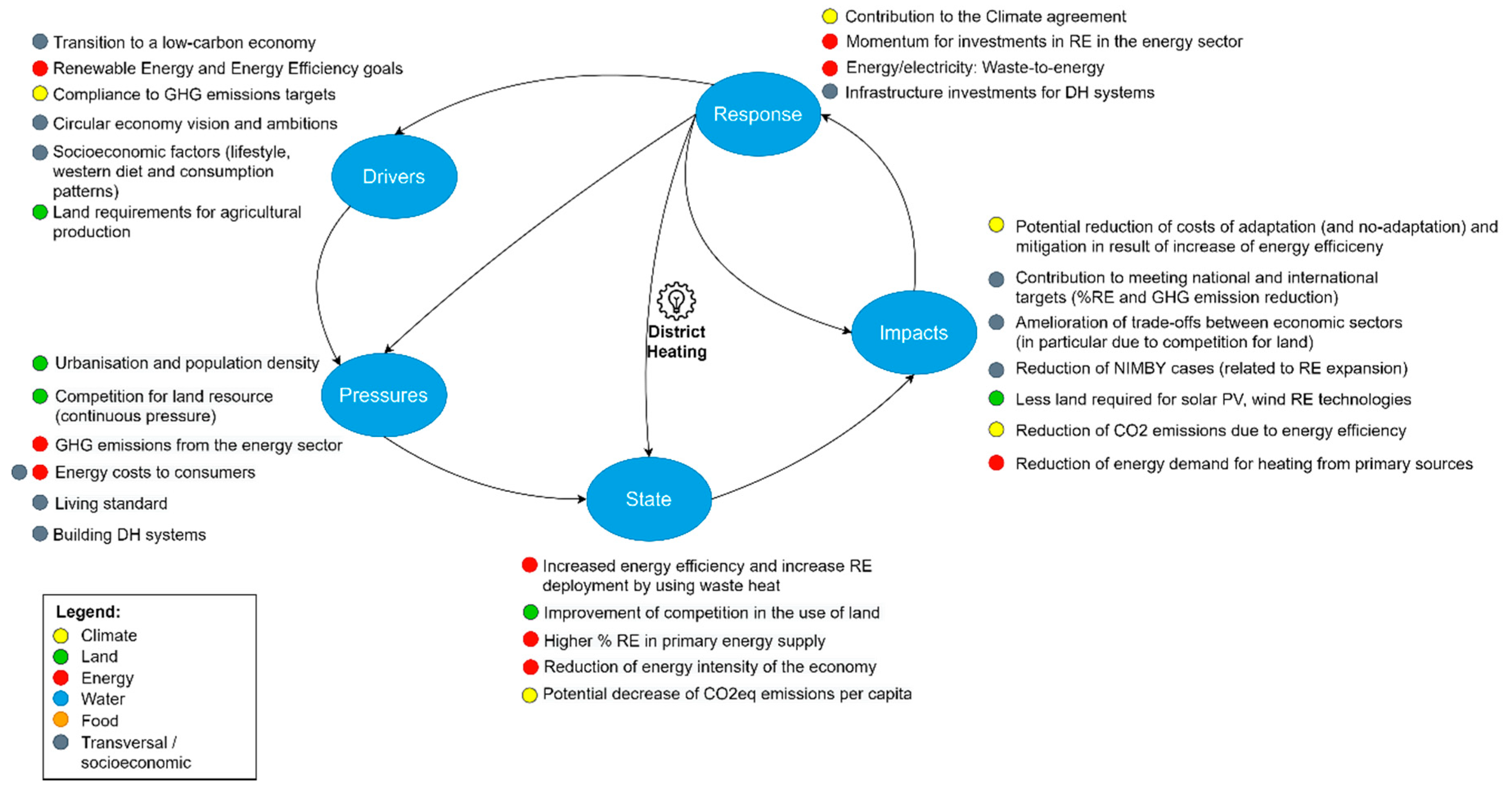


| Effort | Strong ESCO Market | District Heating and Cooling | Green Tax Reform | Weight |
|---|---|---|---|---|
| Equipment and installation | 10 | 4 | 5 | 0.23 |
| Costs throughout implementation | 10 | 10 | 5 | 0.23 |
| Number of stakeholders involved | 5 | 4 | 2 | 0.11 |
| Level of decision involved | 8 | 8 | 1 | 0.11 |
| Need for active monitoring and management | 8 | 4 | 3 | 0.05 |
| Controversy of the topic | 4 | 4 | 0 | 0.05 |
| Technological complexity | 5 | 3 | 3 | 0.07 |
| Maturity of the innovation | 9 | 10 | 3 | 0.05 |
| Natural availability | 7 | 8 | 0 | 0.08 |
| Productivity of crops | 0 | 0 | 0 | 0.02 |
| Total | 7.96 | 6.27 | 3.11 | |
| Reversed score | 2.04 | 3.73 | 6.89 |
| Impact | Strong ESCO Market | District Heating and Cooling | Green Tax Reform | Weight |
|---|---|---|---|---|
| Reduction potential for GHG emissions | 9 | 10 | 10 | 0.33 |
| Contribution to renewable energy generation | 8 | 10 | 9 | 0.11 |
| Speed of visibility of the effect | 9 | 10 | 9 | 0.11 |
| Job creation | 9 | 7 | 10 | 0.03 |
| Increased awareness or involvement | 8 | 10 | 9 | 0.07 |
| Contribution to energy efficiency | 8 | 10 | 10 | 0.28 |
| Direct land savings | 5 | 5 | 7 | 0.07 |
| Total | 8.26 | 9.56 | 9.50 |
| BEL | DNK | DEU | LVA | NLD | SVE | |
| Drivers | ||||||
| EU targets | + | + | + | + | + | + |
| Concerns about climate change | + | + | + | - | + | + |
| Controversy of nuclear power | + | + | + | - | - | - |
| Concerns about energy security | - | + | + | + | - | + |
| Need for economic competitiveness and growth | - | - | + | - | - | + |
| Economic crisis 2008 | - | - | - | + | - | - |
| Division into regions | + | - | - | - | - | - |
| Pressures | ||||||
| Global climate change | + | + | + | + | + | + |
| Global biodiversity loss | + | + | + | + | + | + |
| Global resource depletion | + | + | + | + | + | + |
| Living standard (GDP/capita in 2018 in constant 2011 €1000) | 25.5 | 27.6 | 25.8 | 18.8 | 35.7 | 34.3 |
| Population density (people per sq. km of land area) | 377 | 138 | 237 | 301 | 511 | 25 |
| States | ||||||
| Energy intensity level of primary energy in kg of oil equivalent per 1000 EUR of GDP (2015) | 141.3 | 65.1 | 112.6 | 206.7 | 118.3 | 111.3 |
| GHG emission in tonnes of CO2 equivalent per capita (2015) | 10.8 | 9.3 | 11.4 | 6.0 | 12.2 | 5.6 |
| Share of renewable energy (electricity and heat) (2017) | 9% | 36% | 15% | 39% | 7% | 56% |
| Impact | ||||||
| 2020 EU target already reached in 2017 | - | - | - | + | - | + |
| Responses | ||||||
| Reducing fossil fuel imports | - | + | + | + | - | + |
| Increased utilisation of renewable energy sources | - | + | + | + | - | + |
| Reducing energy consumption or CO2 emissions | - | + | + | + | - | - |
| Clear decision to phase out nuclear power | - | + | + | - | - | - |
| Policies to develop green technologies, industry and employment | - | - | + | - | - | + |
| Decentralised production | - | + | - | - | - | - |
| Regional strategies | + | - | - | - | - | - |
| Over-subsidising of renewable energy generation | + | - | - | - | - | - |
Publisher’s Note: MDPI stays neutral with regard to jurisdictional claims in published maps and institutional affiliations. |
© 2020 by the authors. Licensee MDPI, Basel, Switzerland. This article is an open access article distributed under the terms and conditions of the Creative Commons Attribution (CC BY) license (http://creativecommons.org/licenses/by/4.0/).
Share and Cite
Janssen, D.N.G.; Ramos, E.P.; Linderhof, V.; Polman, N.; Laspidou, C.; Fokkinga, D.; de Mesquita e Sousa, D. The Climate, Land, Energy, Water and Food Nexus Challenge in a Land Scarce Country: Innovations in the Netherlands. Sustainability 2020, 12, 10491. https://doi.org/10.3390/su122410491
Janssen DNG, Ramos EP, Linderhof V, Polman N, Laspidou C, Fokkinga D, de Mesquita e Sousa D. The Climate, Land, Energy, Water and Food Nexus Challenge in a Land Scarce Country: Innovations in the Netherlands. Sustainability. 2020; 12(24):10491. https://doi.org/10.3390/su122410491
Chicago/Turabian StyleJanssen, Davine N. G., Eunice Pereira Ramos, Vincent Linderhof, Nico Polman, Chrysi Laspidou, Dennis Fokkinga, and Duarte de Mesquita e Sousa. 2020. "The Climate, Land, Energy, Water and Food Nexus Challenge in a Land Scarce Country: Innovations in the Netherlands" Sustainability 12, no. 24: 10491. https://doi.org/10.3390/su122410491
APA StyleJanssen, D. N. G., Ramos, E. P., Linderhof, V., Polman, N., Laspidou, C., Fokkinga, D., & de Mesquita e Sousa, D. (2020). The Climate, Land, Energy, Water and Food Nexus Challenge in a Land Scarce Country: Innovations in the Netherlands. Sustainability, 12(24), 10491. https://doi.org/10.3390/su122410491






